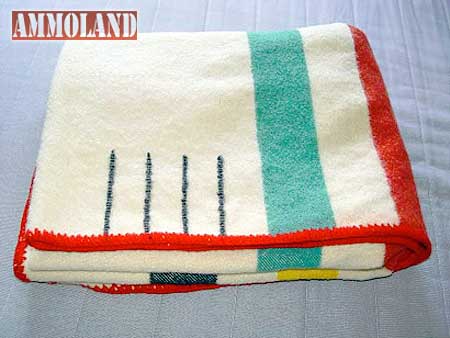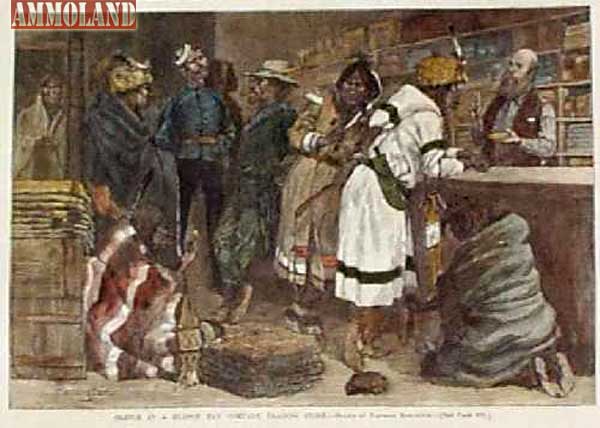By Major Van Harl USAF Ret


Wisconsin –-(Ammoland.com)- When the wife and I were married my mother-in-law gave us a 6 point (queen size) Hudson Bay wool blanket.
We put it on our bed and slept under it for almost two years. After joining the Air Force, during a military move to southern California the moving van with our household “stuff” burned up. We lost everything to include the “point” blanket. Buying the replacement “point” blanket was one of our first purchases after the Air Force settled our loss claim.
I have slept almost every night for thirty years under a Hudson Bay “point” blanket. These blankets are very thick, very warm and last sometimes a lifetime. They have had a strong presence on both sides of the US-Canadian border for over 200 years.
The British Hudson Bay Company (HBC) moved into North American to trade with the native population for animal hides. Blankets were the most sought after trade item. The HBC never made any of these blankets; they were produced in the woolen mills of Witney, England. The “point’ system is based on the size of the blanket a small line is sewn on one corner of the blanket. The more “point” lines, the larger and heaver the blanket, therefore the more a person would have to offer in trade.
The loft of the wool on a “point” blanket has the ability to shed water. Prior to WW II the US military had not progressed, beyond issuing blankets to the troops for sleeping in while out in the “field.” Wool was the chosen material for army blankets.
One of the most important things about wool is that when it is completely soaked it can still provide protection from the elements. Cotton, the other primary fiber used for clothes and blankets, is useless in cold weather when wet.
The army has long had the expression that “cotton kills” in cold weather. HBC “point” blankets have unofficially served the US military since the French and Indian War. Volunteer soldiers would show up to fight, bringing their own rifle, field gear and their HBC blanket. If you look in an LL Bean catalog or go on-line trying to find a modern HBC blanket you will discover they are big. Most current HBC blankets are King (8 point) and Queen (6 point) size, produced to be used on a bed in a home not carried in the field by a soldier.
I found a picture of HBC blanket that belonged to Private Henry Marble of Massachusetts who carried that blanket in the Revolutionary War. It had 1 and ½ points. During that war it was hard to find “point” blankets that were big enough for the soldiers to use in garrison so the quartermaster was authorized to hire local seamstresses to sew two small blankets together. This way the soldier was only technically issued one blanket, per his military allowance.
In the War of 1812 American privateers would attack and capture British ships. Thousand of new “point” blankets were taken and then sold off at auction to Americans, with the US Army getting first crack at the needed blankets. One of the popular colors for “point” blankets during the above three wars was a dark forest green. The trappers had developed a coat made from a “point” blanket. The idea spread to the volunteer militiamen and the first use by American forces of a camouflage uniform was produced.

During the Civil War both sides used “point’ blankets. Union supply officers went into Canada to buy up any and all the items they could find for their soldiers, to include “point” blankets. The British were happy to continue to sell to the Confederacy and a grey with black stripe “point” blanket was very popular with the Rebel soldiers.
Lewis and Clark carried “point” blankets with them. Admiral Richard Byrd took HBC blankets on his expeditions to Antarctic and Mount Everest. American troops traded with Canadian troops in the trenches of WW I for “point” blankets. The Canadians used over 1 million blankets (not all “point”) for that war. Lindbergh flew in a coat made from an HBC blanket and carried “point” blankets in his plane (www.pointblankets.com).
General Charles Lindbergh USAF Res. was buried in a plain coffin with an HBC “point’ blanket that he had brought back from Canada many years before, for his mother. The Colonel and I still give HBC blankets as wedding gifts, but the new couple have to be “good” people and well deserving of a wonderful future family heirloom. The Colonel took an old “point” blanket and made me a poncho (don’t cut up a new $300 HBC blanket to do this) that I wear it all the time in the winter.
Editors Note: Woolrich Point Blankets are very well made and keep to the traditional styling of vintage Point Blankets: Amazon: https://tiny.cc/biul6w
Christmas is coming and so are hard times. This year instead of buying an I-phone or I-pad, how about an I-blanket for someone you really care for. When the power goes out and it is cold that blanket always works.
Major Van Harl USAF Ret.[email protected]
About Major Van Harl USAF Ret.:Major Van E. Harl USAF Ret., a career Police Officer in the U.S. Air Force was born in Burlington, Iowa, USA, in 1955. He was the Deputy Chief of police at two Air Force Bases and the Commander of Law Enforcement Operations at another. He is a graduate of the U.S. Army Infantry School. A retired Colorado Ranger and currently is an Auxiliary Police Officer with the Cudahy PD in Milwaukee County, WI. His efforts now are directed at church campus safely and security training. He believes “evil hates organization.” [email protected]

I have a 3 pointer my mom bought 70 years ago On a trip to Canada. Still good.